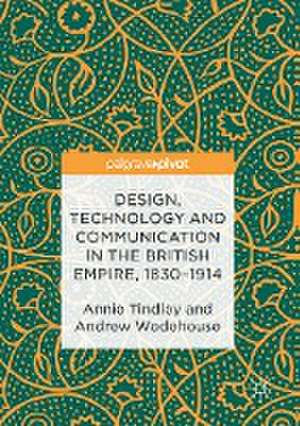Design, Technology and Communication in the British Empire, 1830–1914
Autor Annie Tindley, Andrew Wodehouseen Limba Engleză Hardback – 16 dec 2016
This book is an innovative, interdisciplinary study of the nature of design as a form of communication within and across Britain and its empire in the long nineteenth century. In this period, Britain had developed from the world’s first industrial nation into the ‘Workshop of the World’ but how were technological innovations translated and communicated across the imperial territories? How were designs turned into reality? This book explores these themes, incorporating archival case study technologies such as trains, sugar manufacture and agricultural technologies. Using a four-part framework we firstly examine the identification of innovation opportunities and how these translated to engineering specifications. The realization of conceptual designs through collaboration and their subsequent manufacture and distribution as finished products are then reviewed. Using the authors’ expertise in the fields of historical and design engineering, this study contributes real-world case studies to design theory.
Preț: 384.31 lei
Nou
Puncte Express: 576
Preț estimativ în valută:
73.54€ • 76.32$ • 61.47£
73.54€ • 76.32$ • 61.47£
Carte tipărită la comandă
Livrare economică 15-29 martie
Preluare comenzi: 021 569.72.76
Specificații
ISBN-13: 9781137597977
ISBN-10: 1137597976
Pagini: 145
Ilustrații: XI, 131 p. 10 illus.
Dimensiuni: 148 x 210 mm
Greutate: 0.33 kg
Ediția:1st ed. 2016
Editura: Palgrave Macmillan UK
Colecția Palgrave Pivot
Locul publicării:London, United Kingdom
ISBN-10: 1137597976
Pagini: 145
Ilustrații: XI, 131 p. 10 illus.
Dimensiuni: 148 x 210 mm
Greutate: 0.33 kg
Ediția:1st ed. 2016
Editura: Palgrave Macmillan UK
Colecția Palgrave Pivot
Locul publicării:London, United Kingdom
Cuprins
Chapter One: Introduction: Designing the empire.- Chapter Two: Acquiring markets – the opportunities of empire.- Chapter Three: Defining specifications – the requirements of empire.- Chapter Four: Conceptual development – the imagined empire.- Chapter Five: Realising production – the tools of empire.- Chapter Six: Conclusion: An empire connected?.- Select Bibliography.- Index
Notă biografică
Dr Annie Tindley is Senior lecturer in British History at the University of Newcastle, UK, specialising in modern Scottish, British and Imperial history.
Dr Andrew Wodehouse is Senior lecturer in Design, Manufacturing and Engineering at the University of Strathclyde, UK, specialising in interaction design, creativity and innovative design teams.
Textul de pe ultima copertă
This book is an innovative, interdisciplinary study of the nature of design as a form of communication within and across Britain and its empire in the long nineteenth century. In this period, Britain had developed from the world’s first industrial nation into the ‘Workshop of the World’ but how were technological innovations translated and communicated across the imperial territories? How were designs turned into reality? This book explores these themes, incorporating archival case study technologies such as trains, sugar manufacture and agricultural technologies. Using a four-part framework we firstly examine the identification of innovation opportunities and how these translated to engineering specifications. The realization of conceptual designs through collaboration and their subsequent manufacture and distribution as finished products are then reviewed. Using the authors’ expertise in the fields of historical and design engineering, this study contributes real-world case studies to design theory.
Dr Annie Tindley is Senior lecturer in British History at the University of Newcastle, UK, specialising in modern Scottish, British and Imperial history.
Dr Andrew Wodehouse is Senior lecturer in Design, Manufacturing and Engineering at the University of Strathclyde, UK, specialising in interaction design, creativity and innovative design teams.
Caracteristici
Utilises eleven detailed archival case studies to illustrate a more concrete picture of inter-imperial discourse through technological migration. Employs a post-colonial approach emphasising the fluidity, plurality and circularity of forms of interaction, highlighting the varied nature of colonialism and the role design plays as a language of communication. Bridges, in an innovative and interdisciplinary manner, the history of empire and technology and engineering science.
